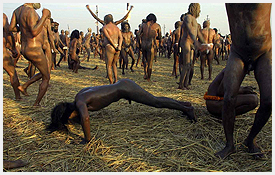» About Haridwar
» About Rishikesh
» About Ujjain
» About Nashik
» About Allahabad
» About Ganga
» About Akharas
» About Ayurveda
» About Yoga
» About Festivals
»About Kumbh Mela
» Ardh Kumbh
» Haridwar Information
» Haridwar Tourist Information
» Ayurveda Tours
» Chandrashilla Sumit Trekking
» Dehradun Mussoorie
» Dodi Tal Trekking
» Gangotri Trek Tour
» Golden Triangle Tour
» Har Ki Dun Trek
» Haridwar Rishikesh Jaipur Tour
» Chardham Pilgrimage
» Kumbh Itinerary Detail
» Footstep Lord Buddha
» Jain Yatra Kutchh
» Kailash Darshan By Foot
» Kailash Darshan By Helicopter
» Lhasa Kailash Mansarovar Yatra
» Muktinath Darshan Yatra

Home - About Yoga
About Yoga
Yoga is a way of life. The word Yoga comes from Indian philosophy, it literally means union, and in this context refers to the union of the individual's soul with the universal.
in this context refers to the union of the individual's soul with the universal.Yoga is a physical discipline; it uses the body and breathing to develop self-awareness and mental clarity.
Yoga is a way of life, an art of righteous living or an integrated system for the benefit of the body, mind and inner spirit. This art originated, was perfected and practiced in India thousands of years ago It is predominantly concerned with maintaining a state of equanimity at all costs.
The most important benefit of yoga is physical and mental therapy.
When you can enter a pose with stillness in the mind the entire poetry of yoga is experienced
Yoga can be more intimidating than other types of exercise. While many types involve more ineloquence, yoga maintains a certain grace, as if it raises a curious eyebrow to the panting and grunting of other routines. Because of this, people sometimes get scared off by yoga, thinking it’s only for those who are extremely flexible, those who are extremely poised, and those who have taken a Lamaze class to prepare for breathing.
Yoga does far more than get you relaxed and help your body to become stronger and more flexible. Although it looks like exercise and conveys the benefits of exercise, it is far more than exercise. It’s done without striving and without forcing, allowing acceptance of our body as we find it: in the present, from one moment to the next. Whether stretching, lifting, or balancing, yoga teaches us to work at our limits, maintaining moment-to-moment awareness.
Aim of Yoga is the attainment of the physical, mental and spiritual health. Patanjali has recommended eight stages of Yoga discipline. They are:
- Yamas- Yamas (abstentions or restrains)
- Niyamas- Niyamas (observances)-austerities, purity, contentment, study, surrender of the ego
- Asana- Physical postures or exercises
- Pranayama - Control of vital energy (Breathing control)
- Partyahara- Withdrawal of the senses
- Dharana- Concentration of the mind (Contemplation)
- Dhyana- Meditation
- Samadhi- Attainment of The super conscious state
Asana is only one of the eight "limbs" of yoga, the majority of which are more concerned with mental and spiritual well being than physical activity. In the West, however, the words asana and yoga are often used interchangeably.
In Sanskrit, the term `yoga` stands for `union`. A yogi`s ultimate aim is to be able to attain this `union` with the Eternal Self with the help of certain mental and physical exercises. It is often said that Hiranyagarbha (The Cosmic Womb) Himself had originally advocated the traditional system of yoga, from which all other yoga schools have evolved. But for all extant knowledge of yoga and its practices, such as yoga sanas and pranayama, the entire credit goes to Maharishi Patanjali.

All the things we teach in yoga, mindfulness, being present; these things make you more capable of doing what you’re doing. ... Awareness, concentration and balance,
An integration strategy consists of a set of short “interweave” practices, throughout the day, creating a powerful meditative momentum in your daily life. It is taking at least a couple minutes out of each hour for consciousness raising activities.
Yoga is a spiritual path of discipline, of mastering the mind and senses with teachings and practices. It is also a path imbued with grace.
History Of Yoga
The oldest written records of Indian culture and yogic activities is found in the Vedas, which are a compilation of hymns and rituals over 3000 years old.The history of yoga is based in the Indus Valley civilization. The techniques are practiced by the Indus to initiate spiritual growth. The yogis encourage union with the finite jiva (transitory self) and with the infinite Brahman (eternal self). Brahman is a term used by the Hindus to mean “God.” So, what are we supposed to unite with? Yogis usually think of God as an impersonal, spiritual substance, coexisting with all of reality. This doctrine is called pantheism which is the view that everything is God. In the Bible, God reveals Himself as the personal Creator of the universe. Unlike the yogis, the Bible presents man’s primary problem to be sin -- a failure to conform to God’s character and standards. The solution is Jesus Christ’s death on the cross. He calls men to freely receive all the benefits of His salvation through faith in Christ alone. Yoga views man’s problem primarily in terms of ignorance. Man simply does not understand he is God so the solution is enlightenment, or an experience of union with God. In order to reach that goal, there must be a lot of striving and effort which is not needed in the Christian viewpoint




